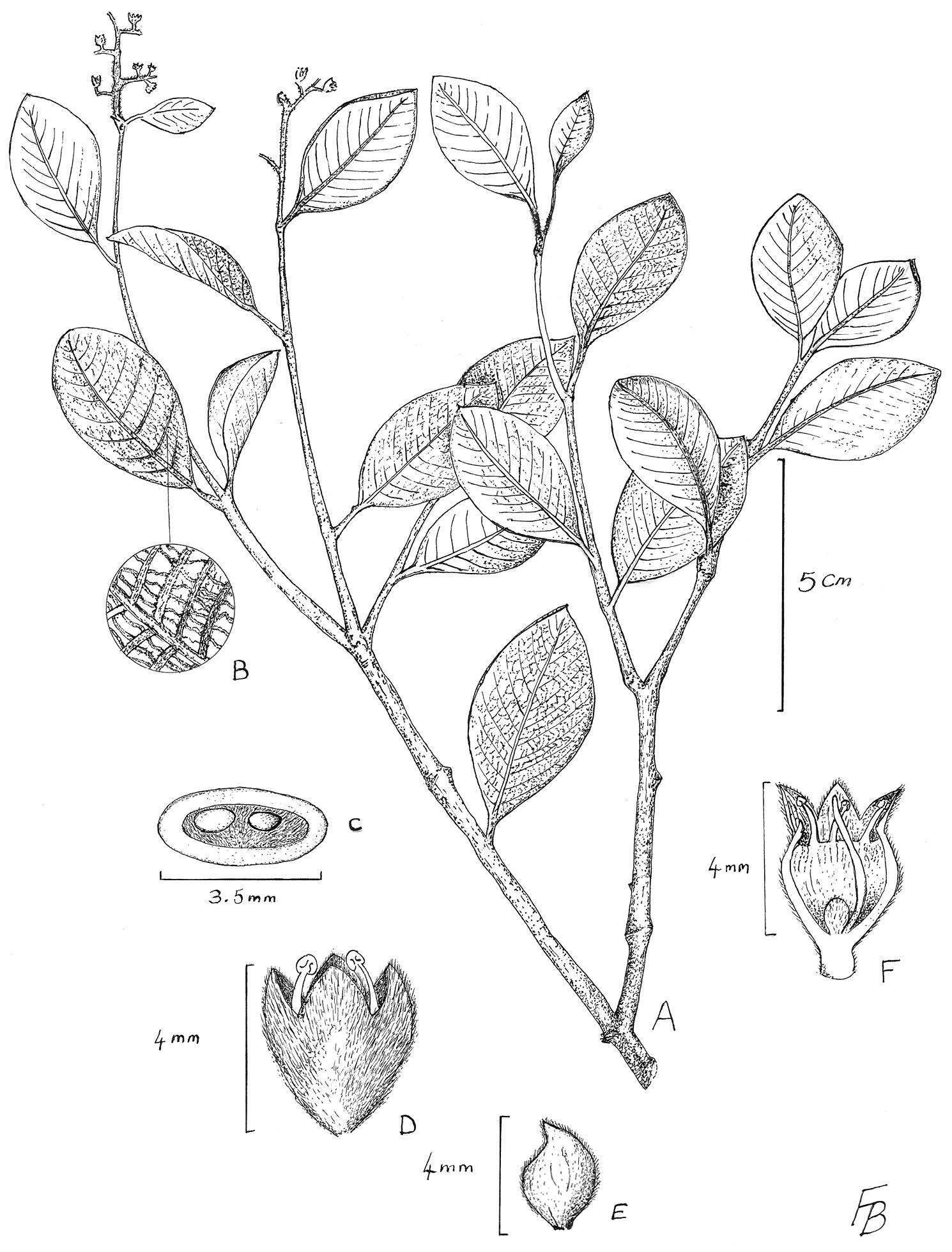






(C) 2013 Ghillean T. Prance. This is an open access article distributed under the terms of the Creative Commons Attribution License 3.0 (CC-BY), which permits unrestricted use, distribution, and reproduction in any medium, provided the original author and source are credited.
For reference, use of the paginated PDF or printed version of this article is recommended.
Citation: Prance GT (2013) A new species of Licania (Chrysobalanaceae) from Cordillera del Cóndor, Ecuador. PhytoKeys 26: 71–74. doi: 10.3897/phytokeys.26.4590
A new mid altitude species of the predominantly lowland genus Licania, Licania condoriensis from Ecuador is described and illustrated.
Chrysobalanaceae, Licania, Cordillera del Cóndor, Ecuador
A worldwide monograph of the Chrysobalanaceae was published in 2003 (
urn:lsid:ipni.org:names:77132009-1
http://species-id.net/wiki/Licania_condoriensis
Fig. 1Ab Licania compacta foliis subcoriaceis, haud nitidibus, haud dense brunneo-tomentosis, staminibus 7-8 differt.
Ecuador. Zamora-Chinchipe, El Pangui, Cordillera del Cóndor, plateau of Contrafuerte, Tres Patines, W of main Cóndor ridge above Jardin Botánico of EcuaCorriente Copper Company, 03°37'48"S, 78°26'50"W, 1685 m. 2 Dec 2005, D. Neill & W. Quizhpe 15076 (holotype K; isotypes, MO, QCNE).
Small tree 3–7 m tall, young branches appressed puberulous, soon glabrous. Leaf lamina broadly ovate, 2.5–6 × 1.5–3.5 cm, subcoriaceous, acute or with short blunt acumen at apex, rounded to subcuneate at base, margins entire, glabrous and dull with densely reticulate prominulous venation above, with well-developed stomatal cavities beneath, the venation flattened around slit-like apertures of cavities, the venation glabrous and the cavities filled by a mass of white, unicellular simple hairs; veins 13–15 pairs, plane above, prominulous beneath; petioles glabrous, 3–10 mm long, rugose, with two sessile glands near apex. Stipules lanceolate, early caducous. Inflorescences short once-branched panicles 3–5 cm long, lateral branches borne at 90 degrees to rachis, the rachis and branches densely yellowish-brown tomentose. Flowers c 2 mm long, sessile or subsessile on primary branches of inflorescence; bracteoles oblong-triangular, acute, 1–1.5 mm long, tomentose on exterior and with ciliate margins. Receptacle campanulate, 1.5 mm long, yellowish-brown tomentose on exterior; calyx-lobes c. 1 mm long, acute, triangular, densely tomentose on exterior, tomentose within; petals absent; stamens 7–8, included, filaments equaling or shorter than the calyx lobes in length, c. 0.8 mm long. Ovary inserted at base of receptacle, unilocular with 2 ovules; style pubescent at base. Young fruit only seen, puberulous, glabrescent, unilocular.
Ecuador. Morona-Santiago: Limon Indanza, Cordillera del Cóndor, Centro Shuar Yunkumas, Cerro Chuank Naint, 03°03'31"S, 78°14'48"W, 1, 130 m, 19 Dec 2005, A. Wisum & Grupo Shuar de Conservación 326 (K, MO, QCNE); same locality, Asociación Nunkui, 03°3'34"S, 78°14'45"W, 1, 150 m, 19 Dec 2005, C. Morales, A. Wisum & C. Kajekai 1593 (K, MO, QCNE).
This distinct mid-altitude Licania belongs to Section Licania of the genus and is probably most closely related to Licania compacta Fritsch from Roraima in Guyana, but differs from Licania compacta in the much less coriaceous, more acute leaves with a dull rather than shiny upper surface and in lacking the dense pubescence that covers the stomatal cavities of the latter and in the greater number of stamens. The leaves of Licania condoriensis are very similar to those of Licania octandra (Hofmanns. ex Roem & Schultes) Kuntze subsp. octandra, but it differs in the fewer stamens (7-8 vs 9-12) that are included rather than far exserted. All collections of Licania condoriensis are from the Cordillera del Cóndor for which this species is named.
Licania condoriensis Prance: A habit B leaf undersurface showing reticulation from the deep stomatal cavities C ovary cross section D flower E bracteole F flower section. (Drawn from Neill & Quizhpe 15076 by Flora Bamford).
Species of Licania (Chrysobalanaceae) occurring mainly at above 1000 m.
| Species | Locality | Altitude |
|---|---|---|
| Licania subgenus Moquilea section Moquilea | ||
| Licania durifolia Cuatr. | Colombia, Ecuador, Peru | 500–2000 m |
| Licania cabrerae Prance | Colombia: Antioquia | 2200–2550 m |
| Licania montana Prance | Venezuela: Lara | 1300–1500 m |
| Licania hedbergii Prance | Ecuador: Napo | 1600 m |
| Licania longicuspidata Prance | Ecuador: Carchi | 650–1800 m |
| Licania cariae A. Cardozo | Venezuela: Aragua | 1100–2000 m |
| Licania chiriquiensis Prance | Panama: Chiriqui | 1007–1200 m |
| Licania subgenus Moquilea section Leptobalanus | ||
| Licania jefensis Prance | Panama: Chiriqui | 1007 m |
| Licania subgenus Licania section Hymenopus | ||
| Licania pakaraimensis Prance | Venezuela: Bolívar | 1400 m |
| Licania subgenus Licania | ||
| Licania subrotundata Maguire | Venezuela: Dist. Federal | 1200–2000 m |
| Licania aracaensis Prance | Brazil: Amazonas | 1000 m |
| Licania pittieri Prance | Venezuela: Aragua | 1100–2200 m |
| Licania tepuiensis Prance | Venezuela: Bolívar | 1350 m |
| Licania condoriensis Prance | Ecuador: Zamora-Chinchipe | 1130–1685 m |
